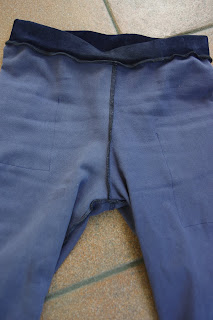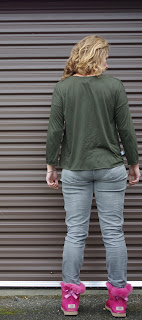Otherwise known as Japanese pattern-copy-hell.
We all know from Japanese pattern books that the pattern pieces are deceptively simple. A few pleats here, a slight angle there, and a pattern piece which is functionally a big square turns into an amazing, truly ingeniously draped work of art.
Despite which, when one of my work colleagues offered to let me borrow this nice dress from the pattern designer Szeki, I said yes with enthusiasm instead of with foreboding. The dress was still on the website as the "kimono dress" in another colour, though I believe the one I was borrowing is a few seasons old.
Here is the original dress that I'm trying to copy.
The fabric is a blend of linen and viscose which gives it a lot of weight, a certain crispness, but also luxurious drape. I had to search to find a similar fabric, which I got from Germany on Etsy. The seller has vanished, but the fabric is great - it was about 50/50 tencel and linen with a slubbed texture - just what I wanted.
In the meantime I had some cotton that I had bought in preparation for this pattern, just plain lawn. However what happened is that I tried to trace the dress onto paper, and something in the middle was getting lost. This dress is 2 copies of one just about rectangular pattern piece, with a mid front seam and a mid back seam. There's a shoulder seam that creates the armholes. So simple...yet not.
I could not properly capture the curve at the shoulder.
I had to cave in and use my fabric to make a muslin. I basically pinned it onto the dress and cut around it and then copied my "muslin" and basted the two pieces together. Then I laid the dress over it and tried to figure out what I'd done wrong.
The complexity was compounded because both the front and the back are V shapes, and I kept mixing them up.
I was excited and so I bought some fabric in the interim, from Miss Maude. It's the viscose by Atelier Brunette so it's still luxury expensive stuff, but much lighter and floatier than the Japanese dress.
After the muslin, I traced that fabric onto a piece of tracing paper, lined *that one* up with the dress again, and finally decided it was as good as I could get. I cut out my first attempt. Here you go:
I had planned to make it shorter than the original anyway, but I only ordered 2 metres of fabric so I ended up also not having enough for the full length. I reshaped the hem after cutting, to try to approach the semi-tulip of the original, and probably overdid it. I just overlocked everything because I had little faith in my final outcome.
On my version the shoulders sit a bit further forward and I originally thought I had it way off. I realised after some tugging that the weight of this dress does not pull it backwards enough, but that my v shapes were close to the original - the back V is a bit smaller. My armholes are much bigger.
I modified the pattern after this, taking a strip out of the pattern piece that would functionally decrease volume and decrease how big the sleeve opening was. I didn't change the V neck.
And finally in the viscose-linen:
I felt very frustrated at the end of all this and glad to be done with it. My second copy mimics the original with all french seams on the inside. It doesn't feel the same as the original when I have it on, but I was really surprised by my photos. They look so similar!
This experience was hard! I'm going to be even more appreciative of complex yet simple patterns, especially Japanese ones, after this. The original dress & the identical copy go back to the owner, but I'm keeping the viscose version for myself. I think it'll do as a summer dress.
We all know from Japanese pattern books that the pattern pieces are deceptively simple. A few pleats here, a slight angle there, and a pattern piece which is functionally a big square turns into an amazing, truly ingeniously draped work of art.
Despite which, when one of my work colleagues offered to let me borrow this nice dress from the pattern designer Szeki, I said yes with enthusiasm instead of with foreboding. The dress was still on the website as the "kimono dress" in another colour, though I believe the one I was borrowing is a few seasons old.
Here is the original dress that I'm trying to copy.
The fabric is a blend of linen and viscose which gives it a lot of weight, a certain crispness, but also luxurious drape. I had to search to find a similar fabric, which I got from Germany on Etsy. The seller has vanished, but the fabric is great - it was about 50/50 tencel and linen with a slubbed texture - just what I wanted.
In the meantime I had some cotton that I had bought in preparation for this pattern, just plain lawn. However what happened is that I tried to trace the dress onto paper, and something in the middle was getting lost. This dress is 2 copies of one just about rectangular pattern piece, with a mid front seam and a mid back seam. There's a shoulder seam that creates the armholes. So simple...yet not.
I could not properly capture the curve at the shoulder.
I had to cave in and use my fabric to make a muslin. I basically pinned it onto the dress and cut around it and then copied my "muslin" and basted the two pieces together. Then I laid the dress over it and tried to figure out what I'd done wrong.
The complexity was compounded because both the front and the back are V shapes, and I kept mixing them up.
I was excited and so I bought some fabric in the interim, from Miss Maude. It's the viscose by Atelier Brunette so it's still luxury expensive stuff, but much lighter and floatier than the Japanese dress.
After the muslin, I traced that fabric onto a piece of tracing paper, lined *that one* up with the dress again, and finally decided it was as good as I could get. I cut out my first attempt. Here you go:
I had planned to make it shorter than the original anyway, but I only ordered 2 metres of fabric so I ended up also not having enough for the full length. I reshaped the hem after cutting, to try to approach the semi-tulip of the original, and probably overdid it. I just overlocked everything because I had little faith in my final outcome.
On my version the shoulders sit a bit further forward and I originally thought I had it way off. I realised after some tugging that the weight of this dress does not pull it backwards enough, but that my v shapes were close to the original - the back V is a bit smaller. My armholes are much bigger.
I modified the pattern after this, taking a strip out of the pattern piece that would functionally decrease volume and decrease how big the sleeve opening was. I didn't change the V neck.
And finally in the viscose-linen:
I felt very frustrated at the end of all this and glad to be done with it. My second copy mimics the original with all french seams on the inside. It doesn't feel the same as the original when I have it on, but I was really surprised by my photos. They look so similar!
This experience was hard! I'm going to be even more appreciative of complex yet simple patterns, especially Japanese ones, after this. The original dress & the identical copy go back to the owner, but I'm keeping the viscose version for myself. I think it'll do as a summer dress.

























































